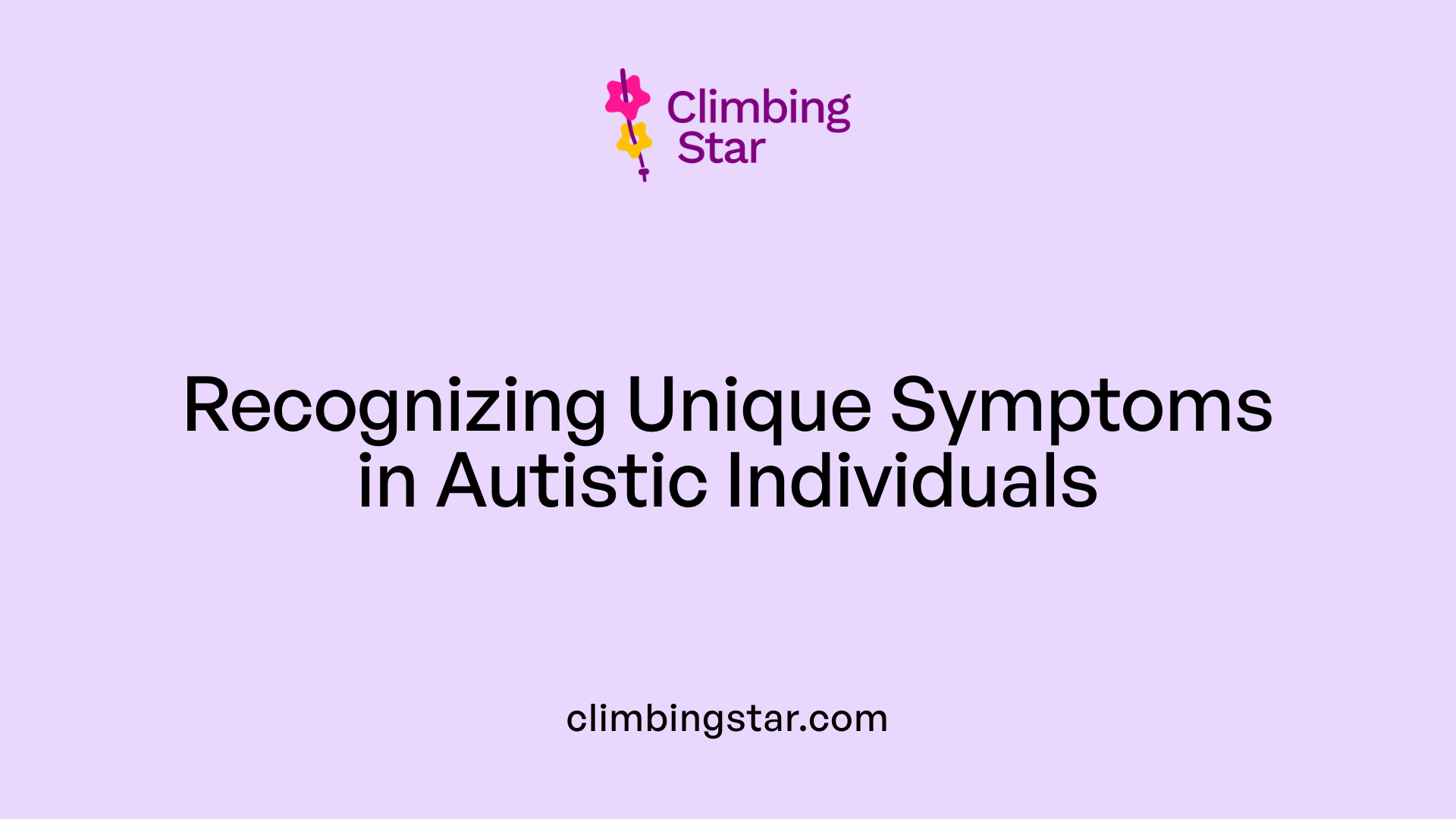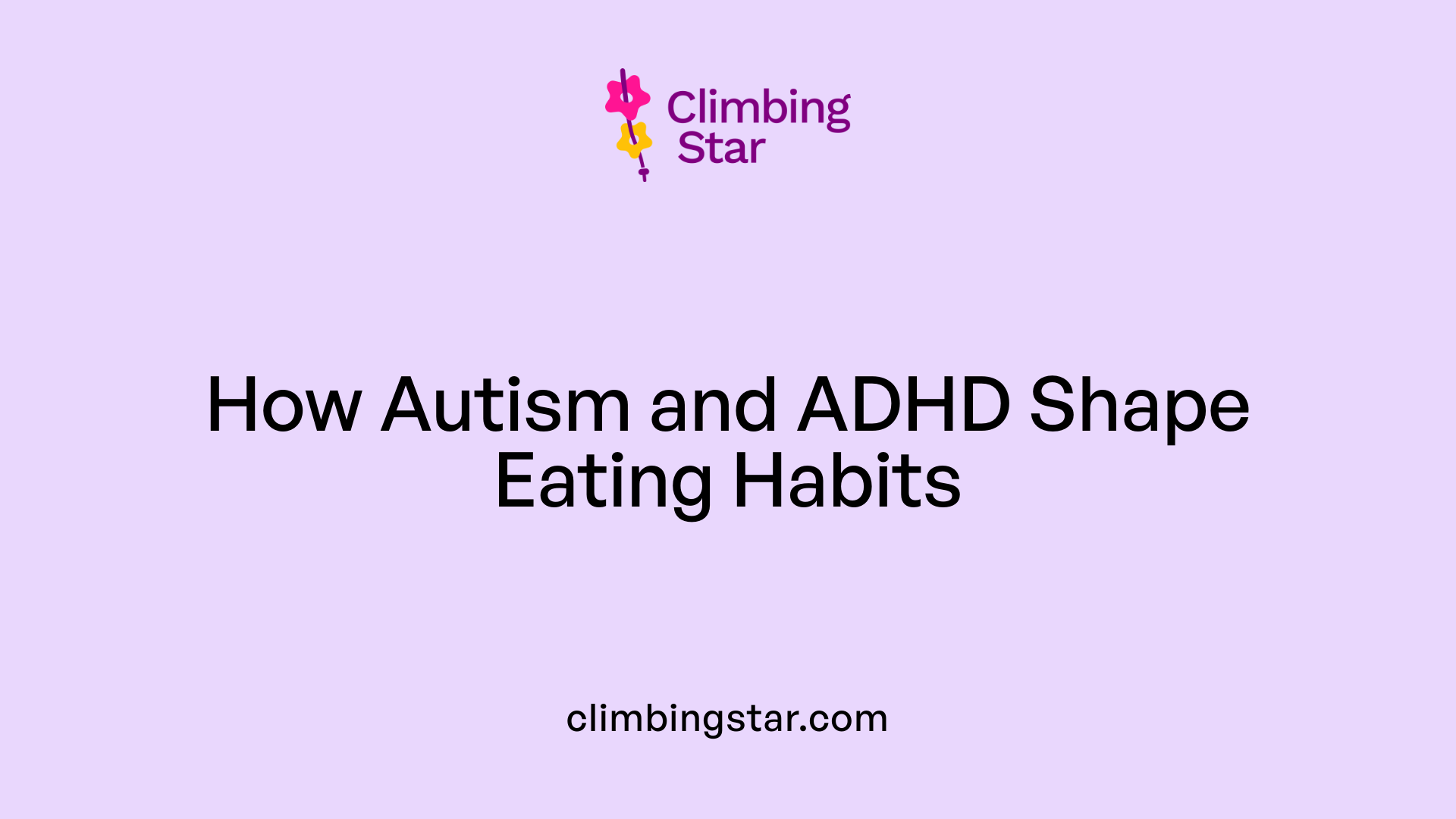Understanding the Overlap Between Neurodevelopmental Conditions and Eating Challenges
Autism spectrum disorder (ASD) is a neurodevelopmental condition affecting approximately 1 in 100 Australians, with profound implications on eating and feeding behaviors. Research indicates a significant relationship between autism and various eating disorders, including anorexia nervosa and Avoidant/Restrictive Food Intake Disorder (ARFID). This detailed investigation explores the prevalence, symptoms, causes, and treatment strategies for eating disorders within autistic populations, emphasizing the importance of tailored approaches for improved health outcomes.
Prevalence and Risk Factors of Eating Disorders in Autistic Individuals
 Research shows that autistic individuals have a notably higher chance of developing eating disorders such as anorexia nervosa and Avoidant Restrictive Food Intake Disorder (ARFID). It is estimated that between 20% and 35% of women with anorexia exhibit elevated autistic traits or are diagnosed as autistic. Similarly, around 44% of children and young people with ARFID are autistic, highlighting a strong link.
Research shows that autistic individuals have a notably higher chance of developing eating disorders such as anorexia nervosa and Avoidant Restrictive Food Intake Disorder (ARFID). It is estimated that between 20% and 35% of women with anorexia exhibit elevated autistic traits or are diagnosed as autistic. Similarly, around 44% of children and young people with ARFID are autistic, highlighting a strong link.
The rates of co-occurrence between autism and eating disorders are significant. Studies report that as many as 16-24% of people with eating disorders show autistic traits, and the prevalence of autism within eating disorder populations can be as high as 23%. This overlap often results in longer treatment durations and poorer treatment outcomes for autistic individuals.
Factors such as sensory sensitivities—like aversions to certain food textures, tastes, or smells—along with a preference for routines and difficulty with sensing hunger or fullness (interoception), contribute to restrictive eating behaviors. Autistic traits such as rigidity and obsession with routines can lead to selective eating and food rituals that resemble clinical eating disorders.
Genetic and neurobiological studies suggest there might be shared underlying mechanisms linking autism and eating disorders. These include common genetic factors and neurobiological pathways involving brain areas responsible for sensory processing and emotional regulation.
Early detection of autism traits is vital for developing effective, individualized treatment strategies. Tailored approaches that respect neurodiversity tend to improve outcomes for autistic people facing eating difficulties, emphasizing the importance of integrated, multidisciplinary care.
| Aspect | Details | Additional Notes |
|---|---|---|
| Prevalence in autistic populations | Up to 35% in women with anorexia, 44% in children with ARFID | High co-occurrence rates |
| Percentage of eating disorder cases with autism traits | 16-24% | Significant overlap affecting treatment outcomes |
| Sensory sensitivities | Food textures, smells, and tastes | Lead to food selectivity and restrictive diets |
| Shared underlying factors | Genetics, neurobiology | Shared causal mechanisms suggested by research |
| Treatment implications | Need for autism-aware interventions | Early, tailored support improves prognosis |
Understanding these complex links emphasizes the importance of specialized assessments and treatments that acknowledge the unique challenges faced by autistic individuals dealing with eating problems. Awareness and flexibility in therapy can significantly enhance recovery prospects and well-being.
Symptoms and Behaviors of Eating Disorders in Autistic Individuals

What are common symptoms and behaviors of eating disorders in autistic individuals?
Autistic individuals with eating disorders often display unique and complex behaviors that set them apart from typical cases. One of the most noticeable signs is ritualistic eating—performing highly structured, repetitive food-related routines that can be rigid and inflexible. For example, they may insist on eating only specific foods or foods prepared in certain ways, shown through strong food preferences and aversions.
Sensory sensitivities also play a significant role. Many autistic people are extremely sensitive to food textures, smells, and sounds. Such sensitivities can lead to picky eating, avoidance of certain food groups, or distress when exposed to unfamiliar food environments. These sensory issues are not merely preferences but can cause physical discomfort or overwhelming sensory overload.
Recognizing hunger and fullness can be challenging for some autistic people. Difficulties with interoception—the ability to sense internal body signals—may mean they are unaware of or misinterpret their hunger cues. This can contribute to restrictive eating patterns or binge episodes, depending on individual needs.
In addition to sensory and routine-based behaviors, autistic individuals often develop obsessive interests around food, such as calorie counting or fixation on specific dietary rules. These obsessions can serve as a coping mechanism to manage anxiety or emotional distress.
Many behaviors associated with eating disorders in autism are not solely motivated by concerns about body image, as seen in other populations. Instead, they may be driven by the need for routine, emotional regulation, or sensory regulation. Because of this, traditional diagnostic approaches may need adaptation to accurately identify and support autistic individuals.
Support strategies that respect these behavioral patterns and sensitivities—such as personalized sensory-friendly diets, visual supports, and routines—are essential. Tailored treatment often involves a multidisciplinary team working to improve eating habits while accommodating autism-specific needs, ensuring better health outcomes and emotional well-being.
Influence of Neurodevelopmental Conditions on Eating and Feeding Behaviors

How do neurodevelopmental conditions such as autism and ADHD influence eating and feeding behaviors?
Autism spectrum disorder (ASD) and attention-deficit/hyperactivity disorder (ADHD) can significantly shape how individuals eat and manage food. These conditions often involve sensory sensitivities, impulsivity, and strong routines, all of which impact eating habits.
Children with autism frequently encounter food selectivity, showing a preference for bland, plain, or highly refined foods. They may avoid foods based on textures, smells, or tastes, leading to restricted diets that can extend into adult life. Behaviors like food refusal, limited food repertoire, or even Pica (consumption of non-food items) are common. Rigid routines around mealtimes, along with obsessive interests in specific foods or food-related rituals, are characteristic features that influence their eating patterns.
Similarly, children with ADHD often display heightened responsiveness to food cues, with tendencies toward emotional overeating or disruptive behaviors during meals. Impulsivity may lead to overeating or choosing quick, convenient snacks over balanced meals. Some traits associated with ADHD, such as difficulty with self-control and emotional regulation, can affect mealtime behavior and eating patterns.
Both autism and ADHD increase the risk of developing disordered eating behaviors, including bingeing or bulimia. Girls with ADHD, in particular, are at a higher risk of eating disorders, influenced by impulsive tendencies and challenges in emotional self-regulation.
Overall, these neurodevelopmental conditions contribute to diverse, and sometimes problematic, eating behaviors. Addressing these behaviors often requires tailored support strategies that consider sensory sensitivities, emotional regulation, routines, and behavioral patterns, leveraging multidisciplinary approaches to improve health outcomes.
Distinguishing Autism-Related Feeding Issues from Eating Disorders

How do feeding issues related to autism differ from or resemble eating disorders?
Feeding difficulties associated with autism usually originate from sensory sensitivities, strict routines, and a desire for sameness. These factors often lead to picky eating, food selectivity, and aversions, particularly to certain textures, smells, or tastes. Typically, these concerns are less severe and less psychologically driven compared to eating disorders.
In contrast, clinical eating disorders such as anorexia nervosa are driven mainly by psychological factors. These may include body image concerns, fear of gaining weight, societal pressures, and a desire for control. As a result, behaviors like food restriction or fasting tend to be more extreme, pathological, and intended to manipulate body weight or shape.
While both conditions involve some degree of food restriction, the motivations behind these behaviors differ significantly. Autism-related feeding issues are often rooted in sensory preferences and routines, whereas eating disorders are mainly motivated by psychological and societal influences.
There is a notable overlap: autistic individuals are at higher risk of developing eating disorders, which can complicate diagnosis and treatment. Distinguishing whether food avoidance stems from sensory aversions or an underlying eating disorder is critical. Accurate understanding of the motivation—sensory and routine-based versus psychological and societal—is essential for implementing effective treatment strategies tailored to each condition.
Resources and Support Systems for Addressing Eating and Autism-Related Challenges
 Individuals and families navigating the complex relationship between autism and eating disorders have access to a variety of tailored support resources. Specialized therapy programs that are designed with sensory sensitivities and routines in mind are essential. For example, the PEACE pathway and guidelines provided by organizations like NICE offer frameworks that adapt interventions to meet the unique needs of autistic individuals.
Individuals and families navigating the complex relationship between autism and eating disorders have access to a variety of tailored support resources. Specialized therapy programs that are designed with sensory sensitivities and routines in mind are essential. For example, the PEACE pathway and guidelines provided by organizations like NICE offer frameworks that adapt interventions to meet the unique needs of autistic individuals.
Support organizations play a crucial role in providing immediate help and long-term assistance. Helplines such as the National Alliance for Eating Disorders, ANAD, the Amaze autism helpline, and Eating Disorders Neurodiversity Australia (EDNA) offer crisis intervention, emotional support, and referrals. These services help families and individuals access personalized care and navigate treatment options.
Educational and advocacy groups also contribute significantly. Entities like the National Eating Disorders Association, the Body Positive, Be Nourished, and the Association for Size Diversity and Health provide valuable resources, including educational materials and community support networks. They promote acceptance and understanding of diverse body types and eating patterns, which is vital for holistic recovery.
Clinicians and families can utilize specific information resources, including specially developed literature and training programs aimed at adapting treatments. These focus on sensory issues common among autistic individuals with eating difficulties, emphasizing the need for individualized care plans.
Combining professional services, community support, advocacy, and tailored therapies creates a comprehensive network that enhances recovery prospects. Early intervention, in particular, is critical and can prevent the development or worsening of eating challenges. Overall, these resources empower families and individuals to manage their conditions more effectively and foster healthier outcomes.
Underlying Causes and Mechanisms Linking Autism and Eating Disorders
What are the underlying causes or mechanisms linking autism and eating disorders?
The connection between autism and eating disorders is complex, involving multiple overlapping factors. At the core, shared neurobiological and genetic influences play a significant role. Research suggests that certain neurobiological pathways and familial genetics may predispose individuals to both conditions.
Autistic individuals frequently exhibit sensory processing challenges, such as sensitivities to textures, smells, and tastes, which can lead to selective eating, food aversions, or conditions like ARFID. These sensory sensitivities often develop before any disordered eating behaviors are observed, indicating they may contribute to the initial emergence of eating difficulties.
Routines and a preference for sameness are hallmark traits of autism. Such rigidity extends to eating habits, where strict routines and ritualistic behaviors around food can make individuals more vulnerable to restrictive eating patterns and obsessive interests related to diet and food. These behaviors serve as coping mechanisms to manage anxiety and emotional distress.
Moreover, many autistic persons experience difficulties with interoception — the sense of internal body states like hunger or fullness — which can distort their perception of needs for food, further complicating eating behaviors.
Psychological traits common in autism, such as heightened anxiety, alexithymia (difficulty recognizing and expressing emotions), and emotional regulation difficulties, also contribute to the development of eating problems. Food may be used as a tool to soothe anxiety or manage overwhelming emotions, especially when expressive and emotional regulation skills are limited.
Finally, there appears to be a bidirectional relationship influenced by overlapping genetic and neurobiological pathways. Environmental and social factors further interplay in this relationship, making it a multifaceted issue. Overall, these interconnected mechanisms create a complex network that links neurodevelopmental traits with disordered eating patterns, emphasizing the importance of tailored approaches to prevention and treatment.
Emerging Research and Future Directions in Autism and Eating Disorder Studies
Current research increasingly emphasizes understanding the complex connection between autism and eating disorders. Scientists are exploring neurobiological and sensory factors that contribute to this overlap. For example, neurocognitive studies from institutions like the University of Aberdeen examine brain structure differences and behaviors such as masking—where autistic traits are hidden—in relation to eating issues.
Research also highlights that autistic individuals are overrepresented among those with eating disorders, often experiencing more severe and persistent symptoms. This includes conditions like anorexia nervosa and ARFID, which frequently co-occur with autism due to shared traits like sensory sensitivities, rigid routines, and emotional regulation challenges.
Recent collaborative efforts, notably the Eating Disorders and Autism Connection (EDAC), focus on developing autism-specific and trauma-informed care. These initiatives aim to address systemic gaps and misconceptions that hinder effective treatment. Emphasizing inclusive approaches, they advocate for tailored therapies that respect sensory sensitivities and communication needs.
Early detection plays a critical role. Identifying autistic traits and eating disorder symptoms within primary care or educational settings allows for timely, specialized interventions. This proactive approach can prevent the escalation of symptoms and support better long-term outcomes.
The future of this research area involves integrating neurocognitive insights with personalized treatment plans. By understanding the neurobiological underpinnings and behavioral expressions, clinicians can offer more effective, affirming care tailored to each individual's needs. Overall, ongoing investigations aim to improve our understanding of these complex overlaps, ultimately fostering better health and well-being for autistic individuals facing eating challenges.
Supporting Autistic Individuals with Eating Challenges
Addressing the intersection of autism and eating disorders requires a comprehensive, tailored approach that considers the unique sensory, emotional, and behavioral needs of each individual. Early intervention, autism-informed treatment strategies, and community support are crucial in improving outcomes. Continued research and increased awareness among clinicians and caregivers can help bridge gaps in understanding, leading to more effective, compassionate care. Emphasizing neurodiversity-affirming practices and family involvement enhances recovery prospects, enabling autistic individuals to achieve healthier, more fulfilling lives.
References
- Eating Disorders and Autism
- Will eating disorder program help with autism-related food ...
- Eating disorders
- Potential mechanisms underlying the association between ...
- Feeding and eating problems in children and adolescents ...
- Eating, eating disorders and autism | What is autism?
- Why So Many People with Autism Have Eating Disorders
- Eating disorders and autism - Beat
- Understanding the Link Between Eating Disorders, Autism ...
- Eating disorders







